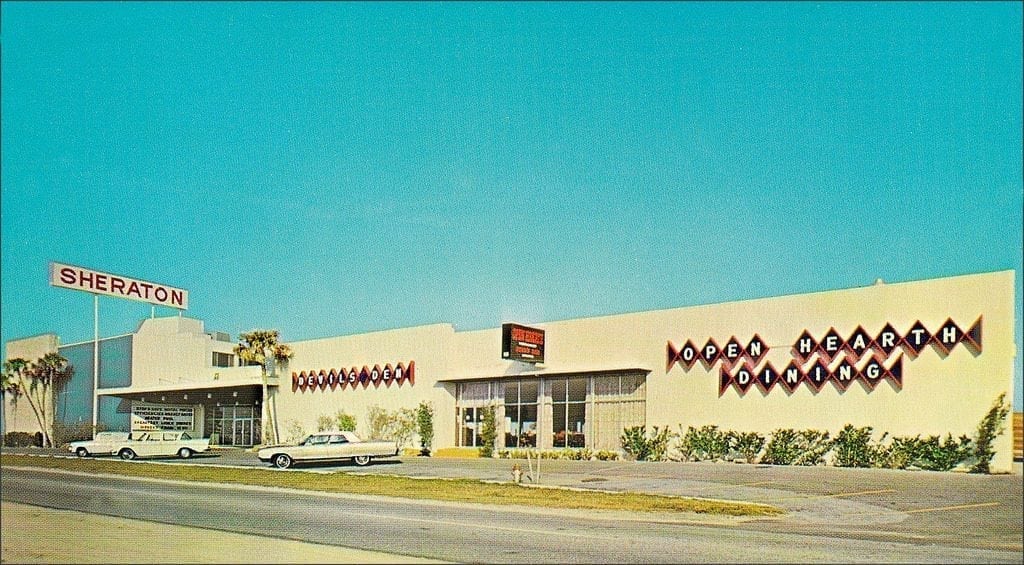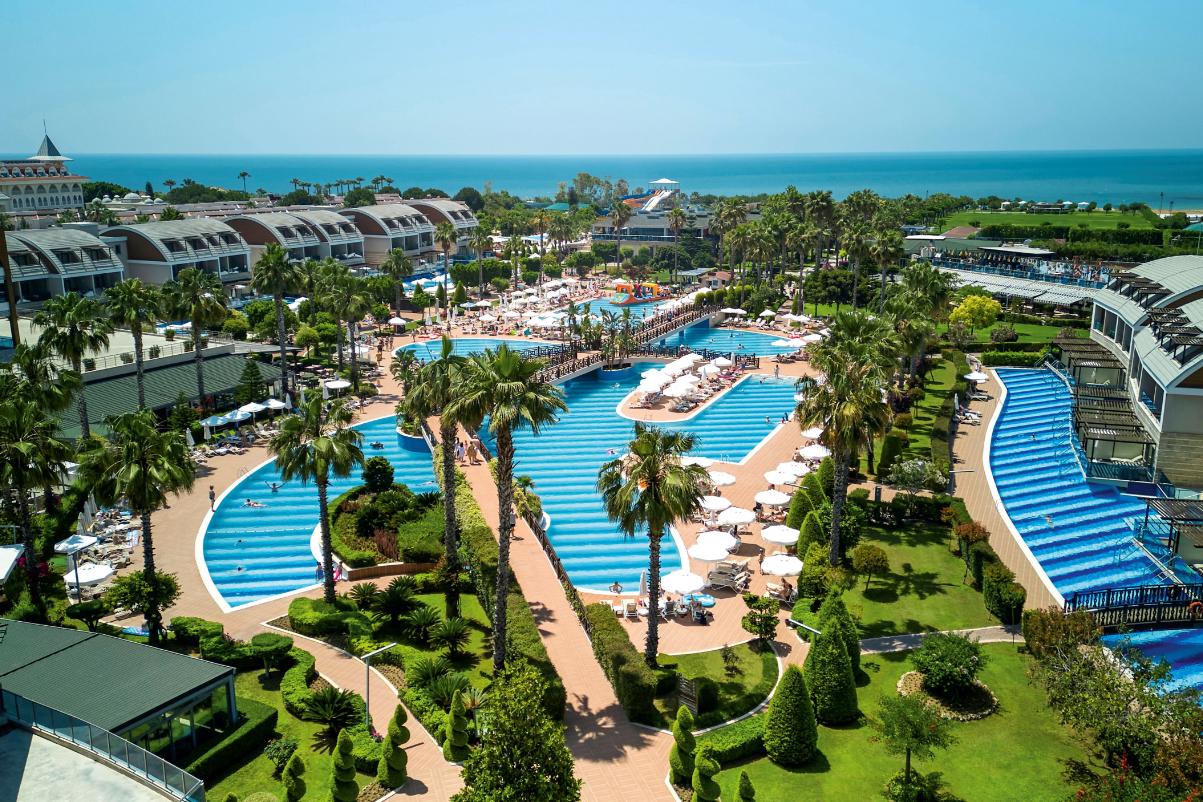How Sheraton Lost Its Way and Marriott's Plans to Bring It Back
Skift Take
Marriott International doesn't just need to refresh the 80-year-old Sheraton hotels brand — it needs to transform it completely.
At the NYU International Hospitality Industry Investment conference last week, we got a chance to see exactly how Marriott intends to do just that. The company, which inherited Sheraton as part of its Starwood Hotels acquisition in 2016, constructed an entire 4,200 square-foot physical space in order to demonstrate to hotel owners and developers what the new Sheraton's public spaces would not only look like, but feel like.
The space itself was sleek, with midcentury modern influences, and at the heart of it was a massive "productivity table," designed to encourage guests and locals to do their work "alone together." Novel features of the table included the ability to lock personal items in a drawer and to wirelessly charge mobile phones.
"Studio spaces" that can be rented ad hoc from the digital "Sheraton Experience Platform" flanked the large communal table, as did smaller soundproofed booths enabling people to take calls and do their work in private. A long "coffee bar/bar" envisioned to seamlessly transition from day to night was another centerpiece of the space, serving local fare that could easily be ordered via mobile.
Overseeing the space was a designated community manager, tablet in hand, who could help guests and visitors easily reserve studio spaces, or order food, etc.
The space was, more or less, an amalgamation of some perennial themes and trends we've seen in hospitality as of late: co-working, all-day dining, flexible meeting spaces, and the kind of tech-enabled integrations you might find in today's more updated airport lounges, like the ability to order food from your mobile device.
Julius Robinson, Marriott's senior vice president and global brand leader for its classic full-service brands (Marriott, Sheraton, and Delta Hotels, not to be confused with the airline of the same name), told Skift that Marriott is also "looking at the potential for co-working opportunities in the Sheraton brand."
"No one's done it in full-service [hotels] at scale and we think there's an opportunity here for Sheraton," Robinson said.
Beyond these initial elements, however, there's much more to the work Marriott needs to do with the hotel brand, founded in 1937, that many in the industry have described as "losing its way" over the decades.
"Everything about the brand is outdated," said Chekitan Dev, a professor of marketing and branding at Cornell University's School of Hotel Administration in the SC Johnson College of Business. "In my opinion, Sheraton is a bland, boxy, and boring brand, squarely positioned in the past as my father's brand," he added, noting that he worked in a Sheraton hotel in the 1980s.
How exactly Sheraton lost its way as a brand, and more importantly, whether Marriott can save it, is one of the biggest brand challenges in the hospitality industry today.
Skift spoke to Marriott executives, as well as a Sheraton hotel owner and various branding experts for their thoughts on this latest attempt to transform the Sheraton brand. Here's what they told us.
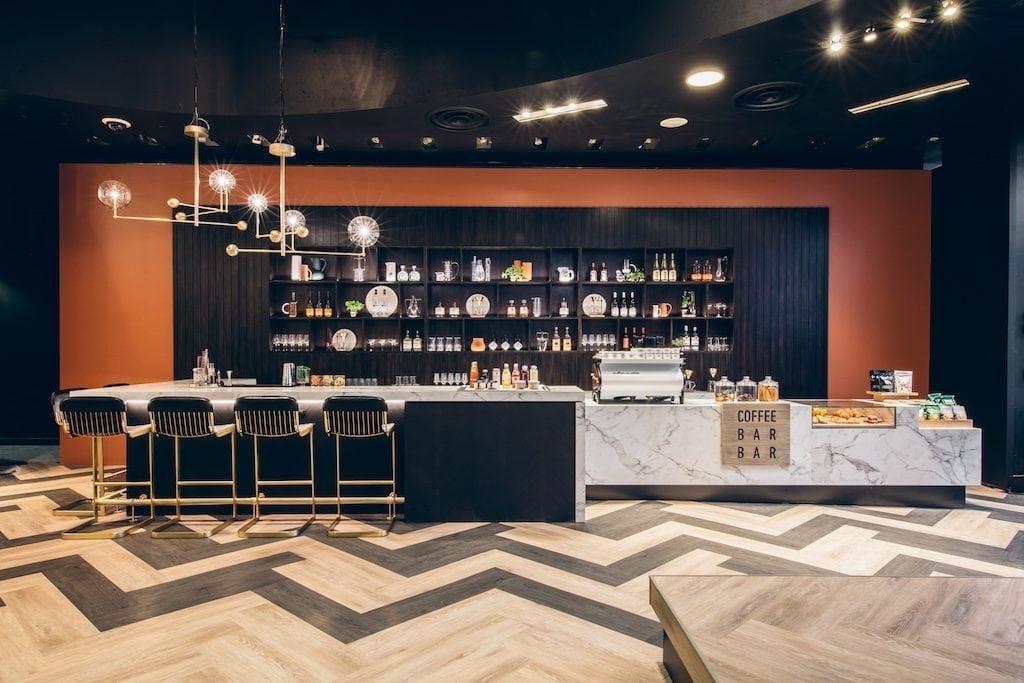
The new Sheraton Coffee Bar/Bar was designed to transition from coffee in the morning to cocktails at night. Source: Marriott International
Sheraton Is Here to Stay
While some — ourselves included — speculated whether Marriott would, after buying Starwood, axe the "tired brand," as former interim Starwood CEO Adam Aron described Sheraton back in 2015, the truth is that Sheraton is too big and too valuable a hotel brand for it to disappear completely.
By the end of 2017, there were a total of 441 Sheraton properties around the world, 192 of which are located in North America and another 122 in Asia Pacific. By room count, it's Marriott's third largest brand, right after the namesake Marriott and Courtyard by Marriott brands.
Sheraton is also the most global of Marriott's 30 brands, and since it's been around since 1937, there are Sheratons that have some of the best locations in world, even if the hotels themselves are a bit outdated.
"It's our third largest fee generator of our brands and in a couple of our continents, it's the No. 1 generator of our brands," said Leeny Oberg, Marriott's chief financial officer. "In terms of fees, rooms, distribution, however you want to slice it, it's a really key brand for us and the overall portfolio."
As massive a brand as it is, however, Sheraton, as a brand, has suffered for a number of years, especially so in North America where it has the largest presence.
"The product quality issues, some of the service culture issues, operational issues, etc., are, I don't want to say they're a distinctly North American issue. That's not the case," said Noah Silverman, Marriott's chief development officer for full-service hotels. "But they're probably most acute in North America. So, as developers have been looking at brands to own and develop, Sheraton has probably fallen somewhat out of favor over the last few years."
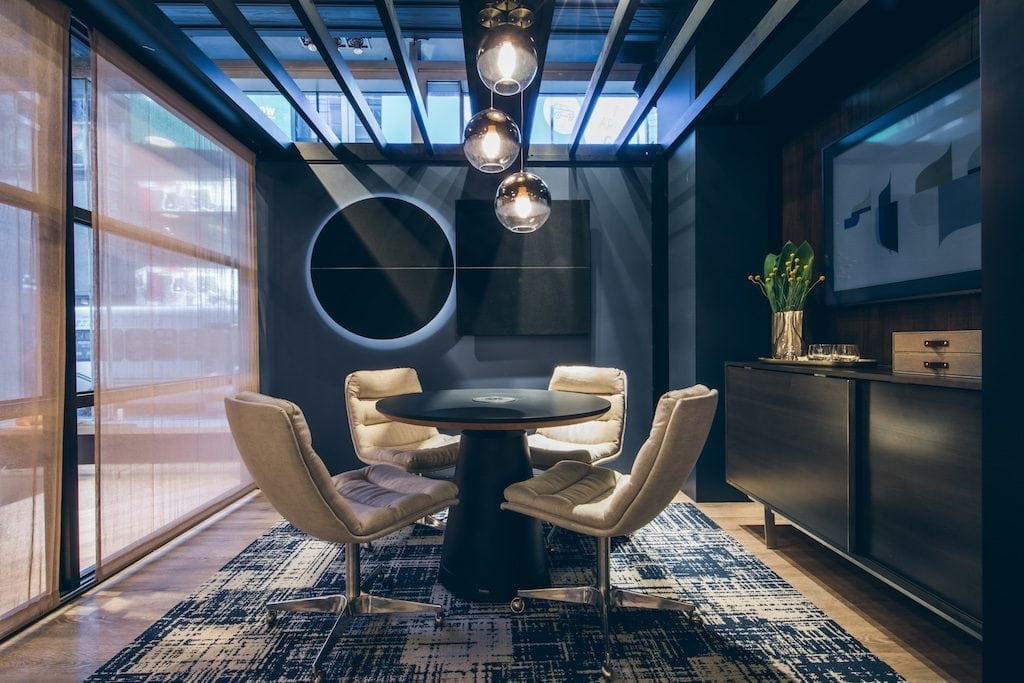
This Sheraton Studio Space can be booked on-demand for impromptu meetings. Source: Marriott International
What Ails Sheraton
For hospitality and travel researcher Bjorn Hanson, a clinical professor at New York University's Jonathan M. Tisch Center of Hospitality, the problems for Sheraton began long before Marriott or even its previous owner — Starwood — owned it.
"It's the diversity of the product and service out there," Hanson said. "Sheraton has evolved to have diversity of both types, which is the worst-case scenario for a hotel brand."
"Sheraton is a case study for why supply segmentation as we know today is so important," Hanson added. "Sheraton tried to be a brand that was a little bit of everything for everyone instead of what it started out to be — a high-end business hotel that wasn't quite luxury."
In other words, you can thank Sheraton for the hundreds of hotel brands in existence today and one reason why hotel companies keep adding more and more brands all the time.
The problems with Sheraton, Hanson said, began when the brand started adding motor inns and motels under the Sheraton name so that, in the U.S. "it had no real identity" and "created confusion for the brand from which it has never recovered in the United States."
Outside of North America, it's a different story. In Asia, in particular, Sheraton moonlights as more of a luxury brand.
When Starwood Hotels & Resorts beat out Hilton to buy ITT Sheraton for $9.8 billion back in 1997, it inherited a brand that had already lost its way. Two years before Starwood bought ITT Sheraton, the lower-priced Four Points by Sheraton brand was launched in 1995 as a repository for underperforming and outdated Sheratons.
"Hilton, in the long run, has to be laughing their butts off," said Reneta McCarthy, a senior lecturer with the Cornell School of Hotel Administration. "Sheraton has been almost like an albatross to Starwood and now, Marriott."
Under Starwood, multiple refreshes for both Sheraton and Four Points were unleashed, the most recent of which was the Sheraton 2020 project, which included a $100 million marketing campaign. But none of Starwood's attempts were all that successful in improving Sheraton's brand perception in North America, primarily because Starwood was reluctant to kick out hotels that didn't meet brand standards.
"I think the one thing Starwood didn't do enough of is they didn't have the courage to say to hotels that were not meeting the standard, 'You're out,'" Marriott CEO Arne Sorenson said. "Even Four Points by Sheraton was a 20-year-old story."
In fact, Sorenson said that one of the reasons why Marriott initially thought it would pass on buying Starwood had to do with Sheraton.
"We looked at Sheraton early in 2015 and decided we'd pass," Sorenson said. "And one of the reasons we'd decided we'd pass initially is, we thought, there's an awful lot of this value which is tied up in Sheraton and it looks like a ton of work. And then, over the course of the summer of 2015, we sort of reconsidered, and in late '15, we signed the deal to acquire Starwood. But we had to get comfortable with this notion that we could do something with Sheraton. And we did."
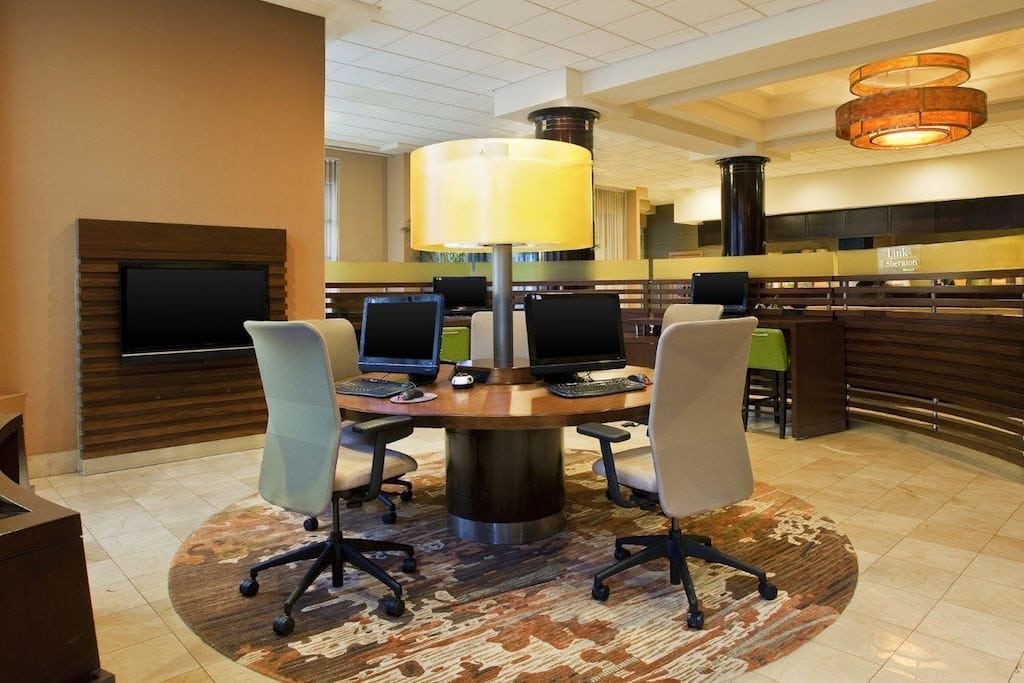
The new Sheraton "productivity table" is an updated take on the Link @ Sheraton cafe/lobby space that Starwood debuted in partnership with Microsoft back in 2008. This Link @ Sheraton is from the Sheraton Suites Wilmington Downtown hotel. Source: Sheraton Suites Wilmington Downtown
The Sheraton Brand's Performance Under Marriott
Since inheriting Sheraton after buying Starwood for $13.3 billion in 2016, Marriott has seen the brand improve slightly in terms of guest satisfaction, occupancy, average daily rate, and revenue per available room (RevPAR).
Cornell's Dev noted that J.D Power's North America Hotel Guest Satisfaction Index Study ratings for Sheraton increased from 810 in 2016 to 818 in 2017 out of a total of 900 points. However, he noted, "In relative terms, compared to its upper upscale cohort, Sheraton is still in dead last position for both years." In fact, Sheraton tied with its sister brand, Delta Hotels & Resorts.
Marriott's Robinson said that since Marriott bought Starwood, the Sheraton brand has seen improvements in its RevPAR index and in its global occupancy and average daily rates.
In North America, Sheraton's RevPAR in 2017, system wide, was $115.99 in 2017, up 1.5 percent from 2016. Its occupancy rate in 2017 was 73.2 percent, up 0.1 percent from 2016. And its average daily rate in 2017 was $158.50, up 1.4 percent from the previous year.
As for the pipeline, or the number of new Sheratons in the works, Marriott says there are 80 more Sheraton properties on the way, representing a total of 5,000 rooms.
"At the moment, we are signing more [Sheraton hotels] than we are opening because it takes a while between when you sign it and when it opens," Sorenson said. "In North America, we are exiting more hotels than we're entering at the moment."
Marriott has been aggressive in exiting Sheraton properties that don't meet the brand's standards, and since 2016, a total of 6,000 rooms have left the Sheraton brand, with another 2,000 rooms expected to leave by the end of 2018.
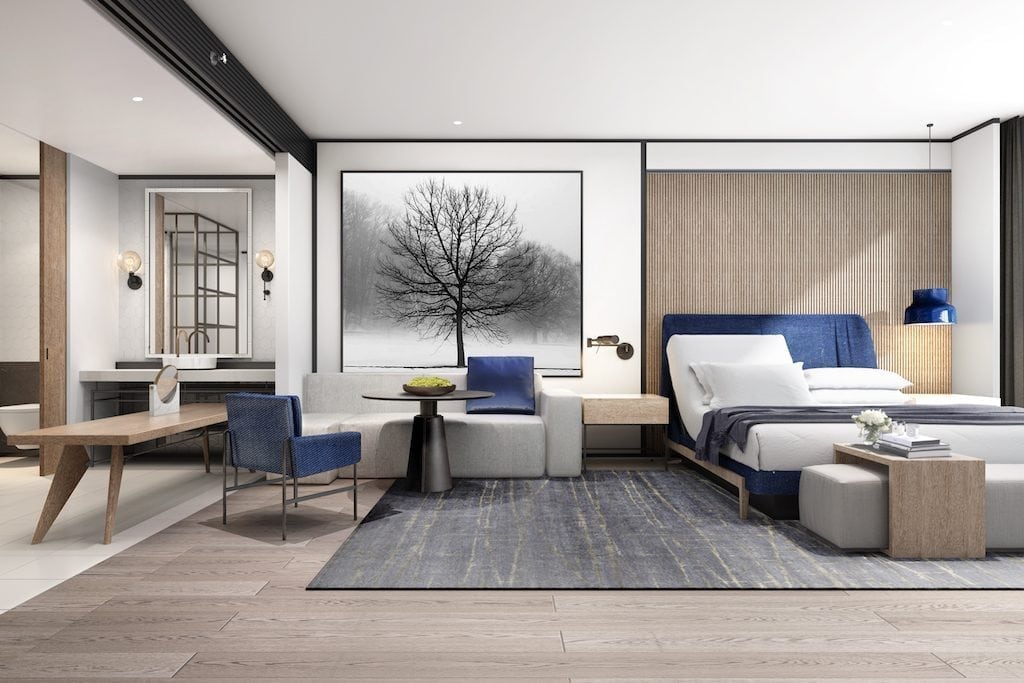
A rendering of the new Sheraton guestroom. The table located near the seating area can be adjusted to different heights. Source: Marriott International
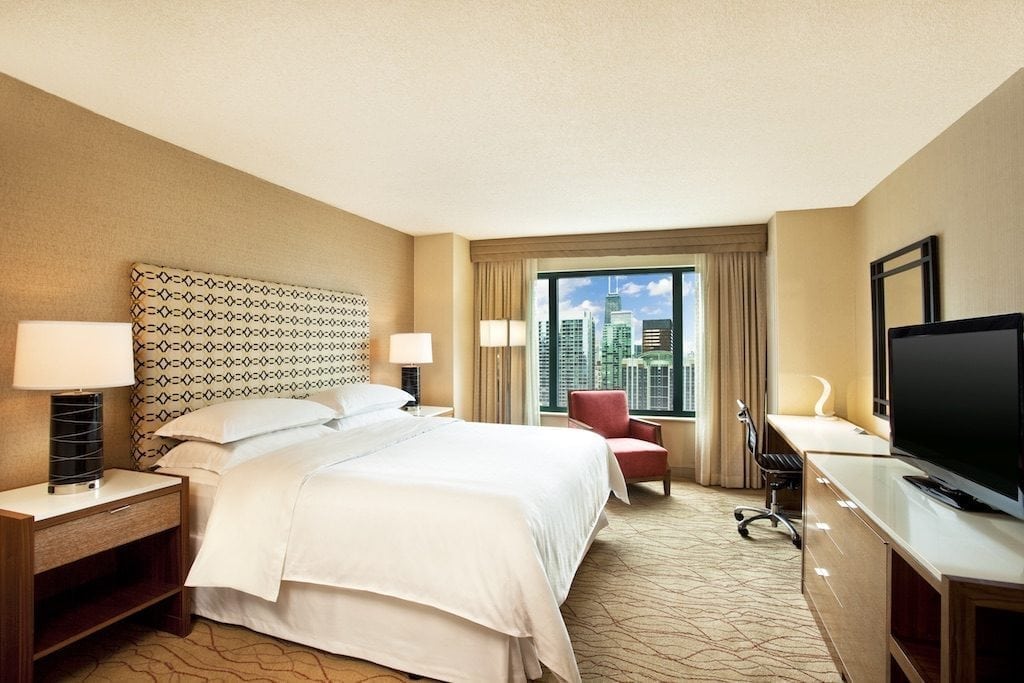
In stark contrast to the rendering of the new Sheraton guestroom, this is what a typical traditional Sheraton king guestroom looks like today in North America. Source: Marriott International
An Owner's Thoughts on Marriott's Plans for Transforming Sheraton
Prior to debuting its designs for the Sheraton's redesigned public spaces this June, Marriott had already begun working on reinvigorating the brand and, thus far, 25 percent of Marriott's Sheraton hotels worldwide are committing to renovations that involve both the guestrooms and public spaces.
Late last year, Marriott debuted a new guestroom design that has since been changed according to hotel owner feedback, said Naveen Kakarla, president and CEO of Hersha Hospitality Management (HHM). HHM's portfolio includes the Sheraton Miami Airport, Sheraton Wilmington South, and Sheraton Pleasanton, and at least one of them is ready for a renovation.
"They rapid prototyped a guestroom and they have changed it twice," Kakarla said. "I would immediately put it into any hotel that I could," he said of the new room design, "and it costs less than what it was going to cost before the Marriott-Starwood transaction."
Kakarla, who also saw the new public space designs in person at the NYU hospitality conference, said he was also impressed by what he saw there, especially in terms of the coffee bar/bar space, productivity table, and bookable studio spaces.
"Outside our hotel industry, you see this in airport lounges and communal working spaces," Kakarla said. "There are a lot of very powerful trends here about what service means. These concepts of communal living and being more casual, and still having the service elements that seem more approachable are better suited for today."
He also said the fact that Marriott's Sheraton transformation operates on a "very efficient cost model" involving both the physical space renovations and the staffing model were appealing — something Marriott also achieved when it repositioned Starwood's Aloft and Element brands.
When asked if he minded the fact that people would linger in the lobbies or at the productivity tables, without purchasing much in the way of food or beverage, Kakarla said he wouldn't mind at all.
"I need the energy in the lobby," he said. "I want it to be approachable to you because it will pay off to me the long term. I'm a big believer in the public space driving equal exposure to the guestroom."
Marriott's Robinson said that while owners were initially "skeptical" of Marriott's plans for transforming the Sheraton brand, the owners who saw the NYU activation "were extremely favorable" and that the most asked question among owners was when some of those new features "would be available for purchase."
Robinson also mentioned the potential for a membership club model to be applied to the brand, perhaps leveraging the combined Marriott Rewards-Starwood Preferred Guest loyalty programs, or drawing on the types of private membership clubs you might find at Soho House or London's The Curtain, for example.
While a marketing campaign for the new Sheraton has yet to be revealed, Robinson said that the overarching concept behind Marriott's Sheraton transformation is about positioning Sheraton as the "world's gathering place."
"We're linking in very heavily to the idea of the Sheraton as the community brand, going back to the roots of the brand, which have always been around the notion of community and the notion of gathering," Robinson said.
Is It Enough to Transform Sheraton for the Better?
To really fix the Sheraton brand, Cornell's Dev recommended the following formula, one he uses for nearly every hotel brand he assesses.
"Sheraton needs at least five things to make it through the next 80 years," he said. "To make a strong statement, be bold; to connect to the lifestyles of its guests, to be relevant; to represent something true to its heritage and capability, or be authentic; offer something new and fresh, be novel; and meaningfully and substantially stand out from the competition, or be different."
Does what we've seen so far from Marriott qualify those five criteria? Reaction from Cornell's Dev and NYU's Hanson was mixed at best.
"Sheraton's plan to remake the lobby as 'the heart and soul' of the hotel is a genius move," Dev said. "Making the space warm and welcoming will be quite a change from the 'train station' image most Sheraton lobbies have always had."
But, he believes owners like Kakarla may have trouble bringing locals into the lobbies.
"I don't envision too many locals saying to themselves, 'Let's meet at the Sheraton,'" Dev said. "The new Sheraton lobby looks more like an airport lounge where you go to be alone — not gather — rather than a Starbucks."
The nature of hotel renovation cycles, which generally span four years, will also be challenging for Marriott, Dev said, noting that only a quarter of Sheraton's hotels will be expected to renovate each year. That means it'll be harder for consumers to actually see or experience the new Sheraton anytime soon.
And because Sheraton competes in the full-service space — one that is increasingly seeing competition from limited-service hotel models that are easier for hotel owners and developers to build and manage, generally — the stakes are that much higher.
Dev said that "there will always be a demand for full-service hotels," but added, "they have to do a better job of being as good as, or even better than, complementary services that are now available locally or online, such as the spa, room service, or concierge.
How Marriott presents the Sheraton brand to hotel owners and developers will also be pivotal in adding to the brand's pipeline and future growth.
"When we think about the positioning of the brand, I would basically put Sheraton between Marriott and Delta," Marriott's Oberg said. "So, if you think about Delta as really being where you would start in the full-service realm, and then you would hit Sheraton and then you would it the Marriott brand. But again, it's important to recognize that it varies meaningfully market to market."
So why would a hotel owner choose to build a Sheraton when she could just as easily build a Delta for less, or consider spending a bit more to build a Marriott?
Hanson wondered if, even with all these new features, if Sheraton's brand identity remains lost or muddled.
"You're taking a brand that doesn't have an identity and giving it a lot of stuff in the form of shared workspaces and these community tie-ins, but it still won't really have its own identity," he said.
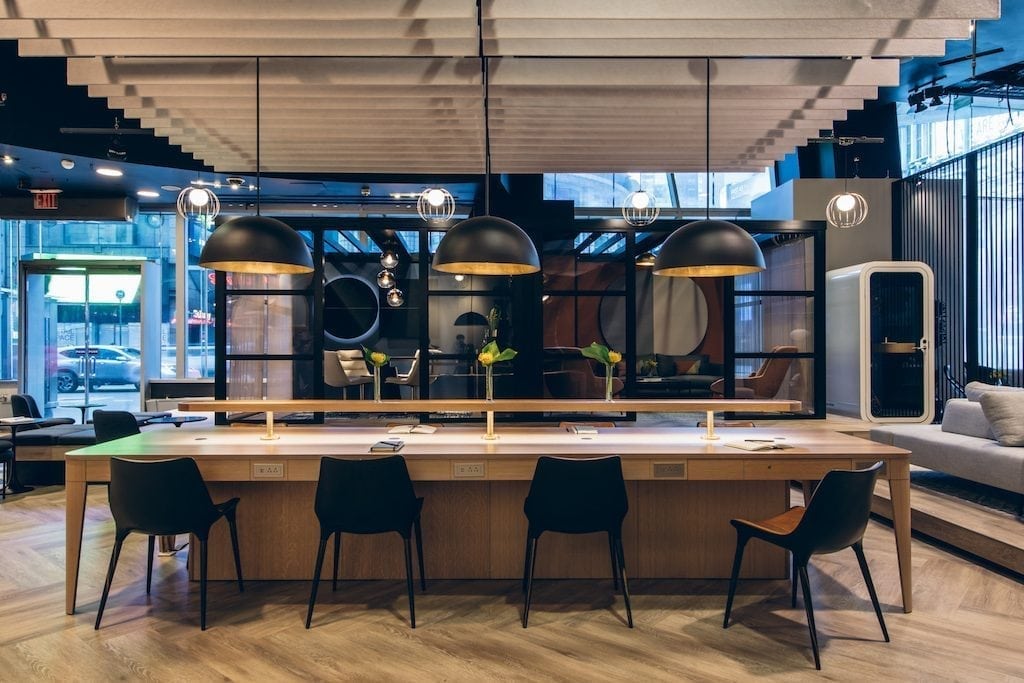
The new Sheraton "productivity table" will be the centerpiece of newly renovated Sheraton hotel properties going forward. Source: Marriott International
Sheraton's Future
While it's clear Marriott has a distinct design directive and cost model for the new Sheraton, what's a bit less clear is what it wants the brand to represent, or what identity the brand will have beyond being "the world's gathering place."
"I think you're right to say they [consumers] don't know exactly what to expect [from the Sheraton brand] because, to be fair, it's not clear what they should expect," Sorenson said. But, he said, over time, as they see the new Sheraton more often, and have better experiences at the hotels, that will help "drive a shift in customer perception about the brand."
Still, he noted Marriott's responsibility to market that message. "We need to articulate this idea that Sheraton is a place where people come together, where communities come together."
And that, Sorenson, Oberg, and Robinson acknowledged, is going to take a number of years, but, hopefully, not another 80.
